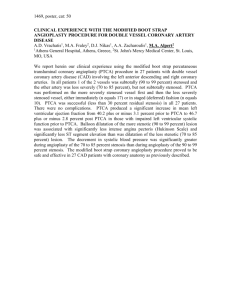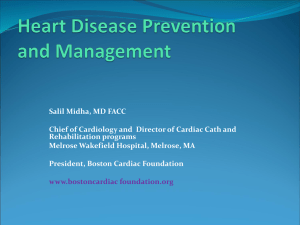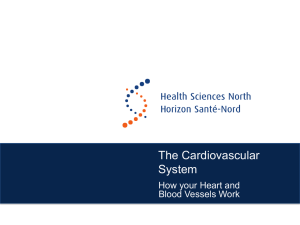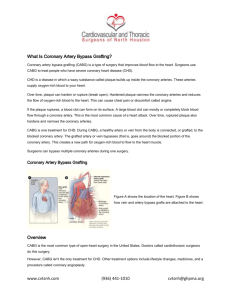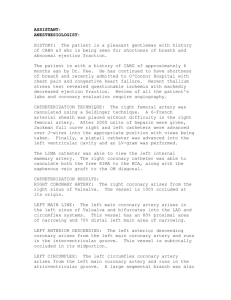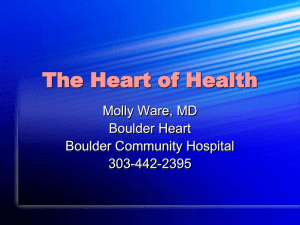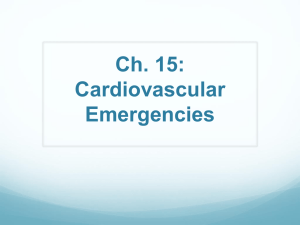Coronary Arteries - Southcoast Health System
advertisement
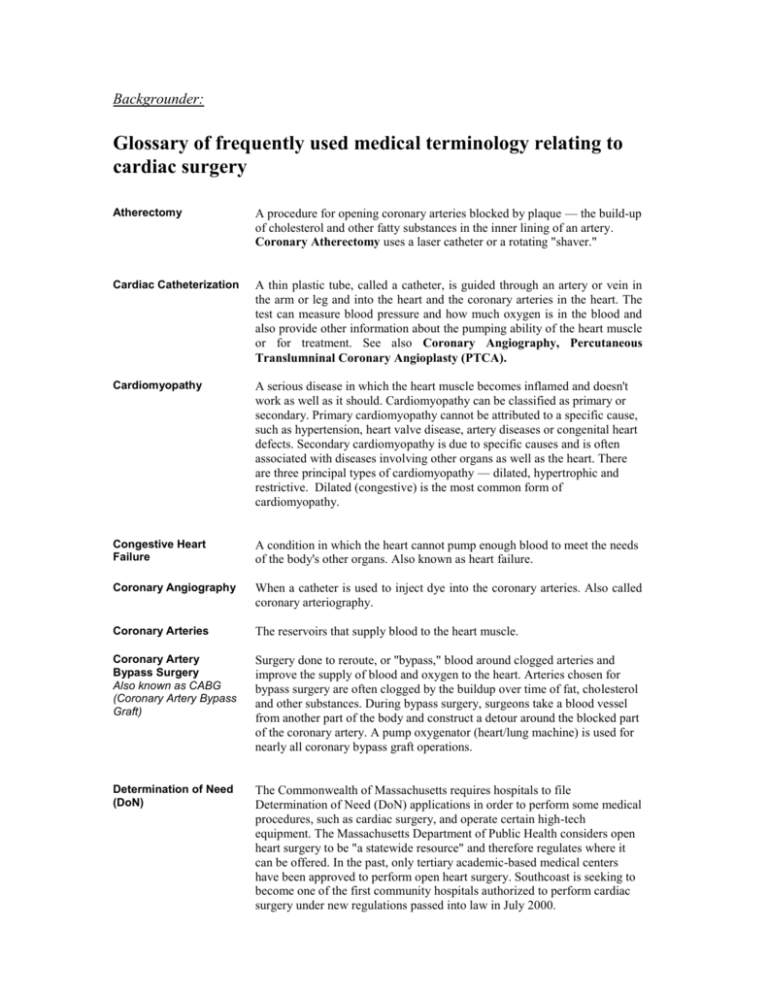
Backgrounder: Glossary of frequently used medical terminology relating to cardiac surgery Atherectomy A procedure for opening coronary arteries blocked by plaque — the build-up of cholesterol and other fatty substances in the inner lining of an artery. Coronary Atherectomy uses a laser catheter or a rotating "shaver." Cardiac Catheterization A thin plastic tube, called a catheter, is guided through an artery or vein in the arm or leg and into the heart and the coronary arteries in the heart. The test can measure blood pressure and how much oxygen is in the blood and also provide other information about the pumping ability of the heart muscle or for treatment. See also Coronary Angiography, Percutaneous Translumninal Coronary Angioplasty (PTCA). Cardiomyopathy A serious disease in which the heart muscle becomes inflamed and doesn't work as well as it should. Cardiomyopathy can be classified as primary or secondary. Primary cardiomyopathy cannot be attributed to a specific cause, such as hypertension, heart valve disease, artery diseases or congenital heart defects. Secondary cardiomyopathy is due to specific causes and is often associated with diseases involving other organs as well as the heart. There are three principal types of cardiomyopathy — dilated, hypertrophic and restrictive. Dilated (congestive) is the most common form of cardiomyopathy. Congestive Heart Failure A condition in which the heart cannot pump enough blood to meet the needs of the body's other organs. Also known as heart failure. Coronary Angiography When a catheter is used to inject dye into the coronary arteries. Also called coronary arteriography. Coronary Arteries The reservoirs that supply blood to the heart muscle. Coronary Artery Bypass Surgery Also known as CABG (Coronary Artery Bypass Graft) Surgery done to reroute, or "bypass," blood around clogged arteries and improve the supply of blood and oxygen to the heart. Arteries chosen for bypass surgery are often clogged by the buildup over time of fat, cholesterol and other substances. During bypass surgery, surgeons take a blood vessel from another part of the body and construct a detour around the blocked part of the coronary artery. A pump oxygenator (heart/lung machine) is used for nearly all coronary bypass graft operations. Determination of Need (DoN) The Commonwealth of Massachusetts requires hospitals to file Determination of Need (DoN) applications in order to perform some medical procedures, such as cardiac surgery, and operate certain high-tech equipment. The Massachusetts Department of Public Health considers open heart surgery to be "a statewide resource" and therefore regulates where it can be offered. In the past, only tertiary academic-based medical centers have been approved to perform open heart surgery. Southcoast is seeking to become one of the first community hospitals authorized to perform cardiac surgery under new regulations passed into law in July 2000. Minimally Invasive Direct Coronary Artery Bypass Grafting (MIDCABG) The goal of MIDCABG is to avoid using the heart/lung machine. It's performed while the patient's heart is still beating and is intended for use when only one or two arteries will be bypassed. MIDCABG uses a combination of small holes, or "ports," in the patient's chest and a small incision made directly over the coronary artery to be bypassed. The cardiac surgeon usually detaches an artery from inside the chest wall and re-attaches it to the clogged coronary artery. The surgeon views and performs the attachment directly, so the artery to be bypassed must be right under the incision. Myocardial infarction or "Heart Attack" Heart attacks result from coronary heart disease (CHD) — blood vessel disease in the heart. A heart attack occurs when the blood supply to part of the heart muscle itself — the myocardium — is severely reduced or stopped. Open Heart Surgery Open heart surgery is performed on the heart while the bloodstream is diverted through a heart/lung machine. The surgery includes heart valve replacements, coronary artery bypass graft (CABG) surgeries, heart transplants and other open heart procedures. Percutaneous Transluminal Coronary Angioplasty (PTCA) A procedure known as coronary artery balloon dilation, or balloon angioplasty. PTCA is a procedure used to dilate (widen) narrowed arteries. A doctor inserts a catheter with a deflated balloon at its tip into the narrowed part of the artery. Then the balloon is inflated, compressing the plaque and enlarging the inner diameter of the blood vessel so blood can flow more easily. Then the balloon is deflated and the catheter removed. It is a less traumatic and less expensive alternative to bypass surgery for some patients with coronary artery disease. Stent Procedure A procedure using a wire mesh tube, called a stent, to prop open an artery that has recently been cleared using angioplasty. References: American Heart Association 1999, Heart and Stroke A-Z Guide. The American Medical Association, Encyclopedia of Medicine, Random House, 1989. Weaver, Litwin, Martin, Use of Direct Angioplasty for Treatment of Patients with Acute Myocardial Infarction in Hospitals With and Without On-Site Surgery, Circulation: 1993 [part 1]: 2067-2075. ###



